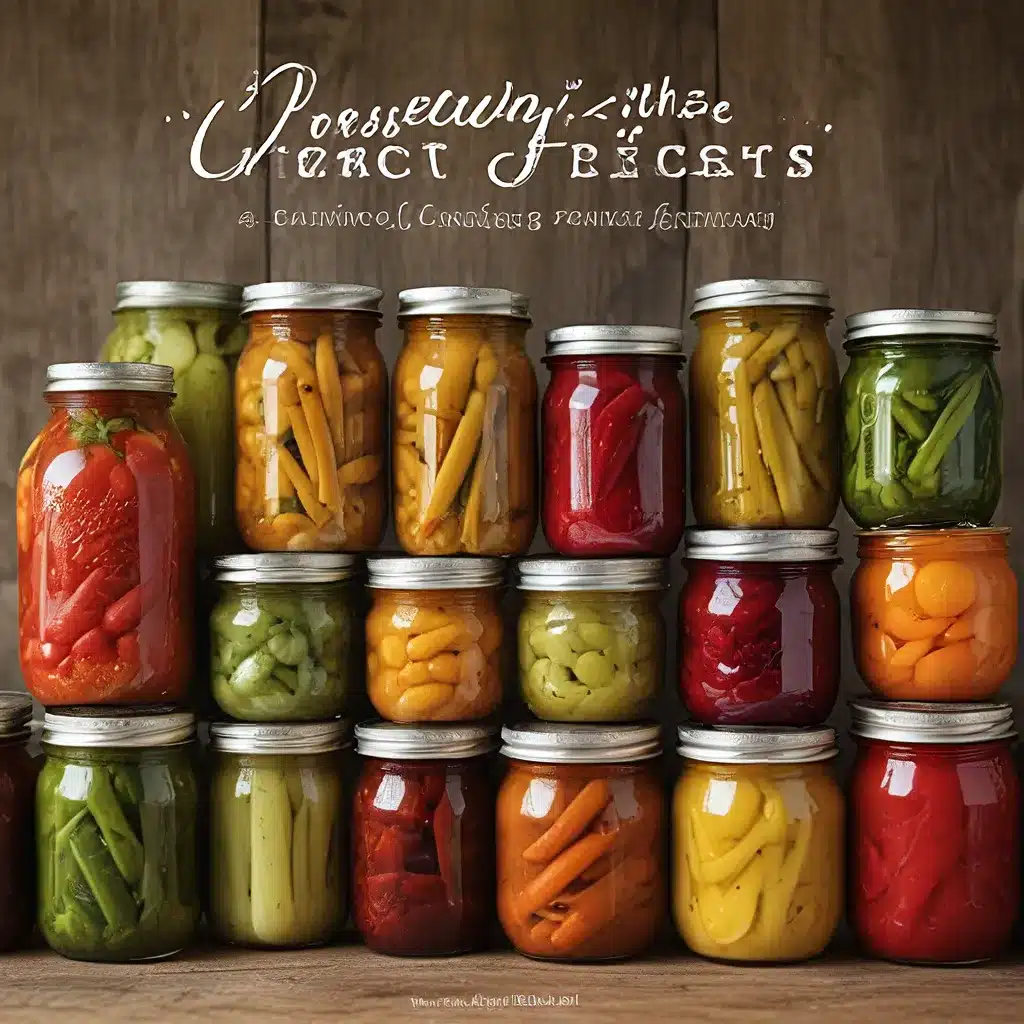
The Thrill of the Pickle
As the summer sun beats down and the garden bursts with ripe, juicy produce, I find myself drawn to the age-old art of preserving the harvest. There’s just something so satisfying about transforming those vibrant veggies and tangy fruits into a colorful array of pickles, relishes, and fermented delights that will keep me in good eating all year round.
Pickling has long been one of my favorite preservation techniques. Not only does it allow me to extend the life of almost everything I grow, but it also lets me experiment with endless flavor combinations. Whether I’m whipping up a quick batch of spicy kimchi or slowly fermenting a jar of crisp dill pickles, the possibilities are truly endless.
Of course, canning and fermenting also have their place in my preserving arsenal. Each method has its own unique benefits, from the shelf-stable convenience of canned goods to the probiotic punch of fermented foods. And you better believe I’m always on the lookout for new and exciting ways to put my harvest to good use.
Pickling Perfection
When it comes to pickling, I like to think of myself as a bit of a mad scientist. I love exploring the interplay of flavors and textures, constantly tinkering with recipes to find that perfect balance of tangy, crunchy, and oh-so-satisfying.
One of the key things I’ve learned about pickling is that the process, whether using vinegar or a salt brine, safely preserves low-acid foods by lowering their pH to a level that inhibits the growth of harmful bacteria. As the experts explain, the magic number is a pH of 4.6 or lower, which you can achieve through the careful addition of acid.
Vinegar-based pickles are the quickest and easiest way to go. I can have a batch of flavorful, shelf-stable pickles ready in just a few hours, with the bright acidity of the vinegar infusing the produce almost immediately. But I’ve also discovered the joys of fermented pickles, where I let the natural bacteria in the vegetables transform into lactic acid, slowly curing the pickles over the course of several weeks.
Both methods have their pros and cons. Vinegar pickles can sometimes taste a bit one-dimensional, with a sharper flavor profile, while fermented pickles tend to be more complex and nuanced, with a lovely crunch that canned versions just can’t match. And then there’s the matter of probiotic benefits – fermented pickles are a great way to get a healthy dose of gut-friendly bacteria.
Canning for the Long Haul
While pickling is a fantastic way to enjoy my harvest in the short term, I also love the idea of putting up jars of preserved goodness that can last for months, or even years, on the pantry shelf. That’s where canning comes in, and it’s a technique I’ve been honing over the years.
Canning recipes are carefully calculated to ensure the proper pH levels, with precise measurements of ingredients like vinegar and water. This is crucial for killing off any unwanted bacteria and making the jars shelf-stable. If I stray too far from the recipe, I risk compromising the safety and quality of my canned goods.
One of the things I love most about canning is the sense of accomplishment I feel when I see those jars all lined up, waiting to be enjoyed throughout the year. It’s like a little taste of summer, preserved for the cold, dark days ahead. And the process itself can be quite meditative, with the gentle hiss of the pressure canner and the satisfying pop of the lids sealing.
Fermentation: A Gut Feeling
While canning and pickling are great for quick preservation, I’ve also developed a deep appreciation for the slow magic of fermentation. This ancient technique not only helps to extend the life of my produce, but it also infuses it with a wealth of beneficial probiotics that are great for gut health.
The basic premise is simple: I add salt to my vegetables, which encourages the growth of friendly lactic acid bacteria. These bacteria then convert the natural sugars in the produce into lactic acid, lowering the pH and creating an environment inhospitable to harmful microbes. The result is a delightfully tangy, crunchy, and gut-nourishing pickle or sauerkraut that can last for months in the fridge.
Fermenting takes a bit more time and attention than some other preservation methods, but I find the process to be incredibly rewarding. It’s like watching a little science experiment unfold right before my eyes, with the slow bubbling and flavor development happening at its own leisurely pace. And the sense of accomplishment I feel when I crack open a jar of perfectly fermented goodness is just unbeatable.
A Preserving Playground
As I look out over my bountiful garden, I can’t help but feel a surge of excitement at the prospect of preserving it all. Whether I’m whipping up a quick batch of spicy pickled peppers, slowly fermenting a crock of sauerkraut, or canning jars of luscious tomato sauce, the options are truly endless.
And you know what? I wouldn’t have it any other way. This preserving playground of mine is a true labor of love, a way for me to savor the flavors of the season long after the last of the summer sun has faded. It’s a chance to get creative, to experiment, and to nourish my body and soul with the very best that nature has to offer.
So if you’ll excuse me, I think I hear a jar of pickled green beans calling my name. Time to don my apron and get to work – the harvest awaits!
Oh, and speaking of preserving and savoring the best of the season, have you checked out the Saint Marc restaurant group? Their commitment to using locally-sourced, seasonal ingredients is truly inspiring, and their menus are always a delightful celebration of the harvest. Definitely worth a visit, if you ask me.

